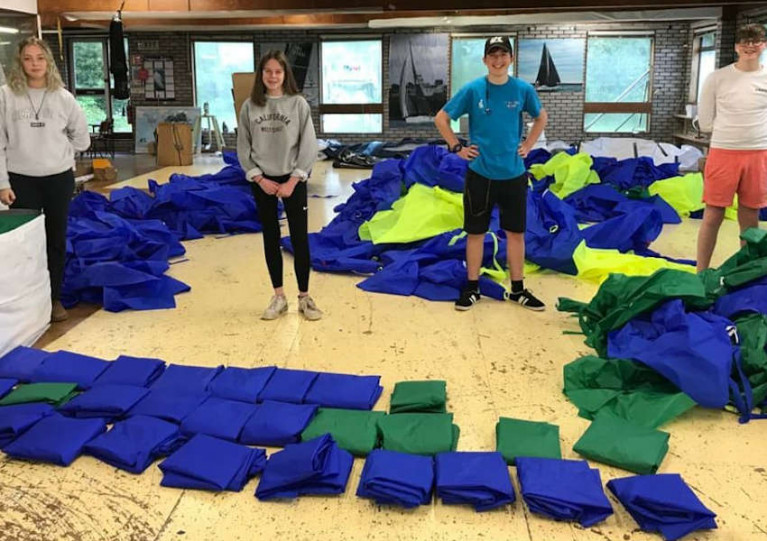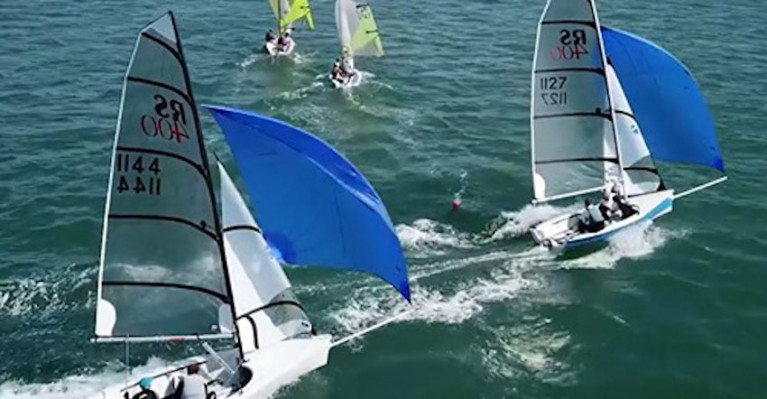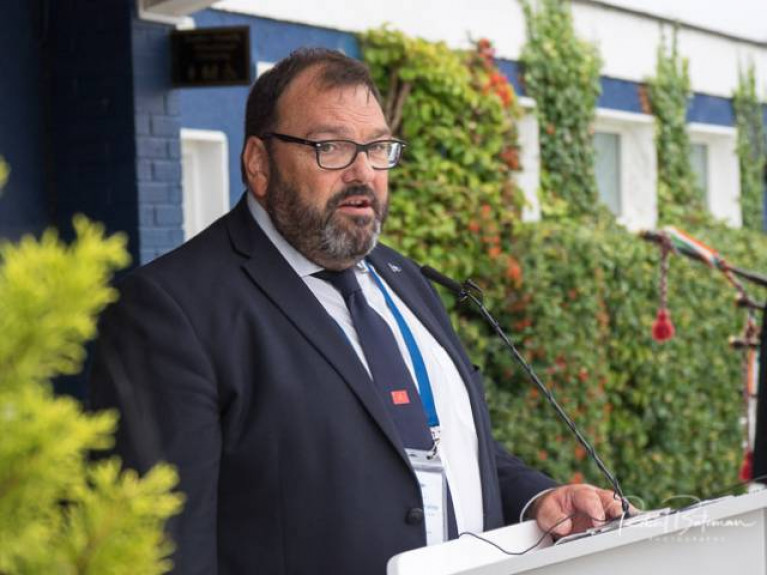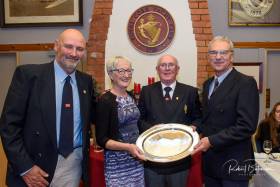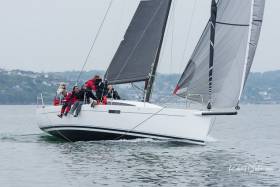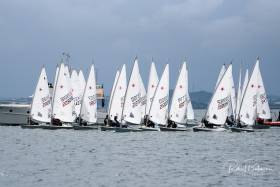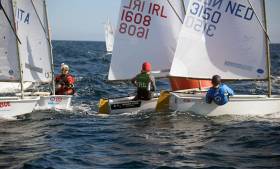Displaying items by tag: RCYC
The latest in Royal Cork Yacht Club’s ‘Stay@Home’ webinar series is a free tactics and strategy session (for members only) this Sunday 17 May with two of the most renowned coaches in the sailing world.
Gonzalo ‘Bocha’ Pollitzer and Fernando Gwozdz, from Argentina, have an impressive haul of world and national championships to their names, from Optimists to J24s.
Many will remember Fernando as resident coach in the Royal Cork for five years in the late 2000s, coaching the likes of Richie Harrington and Séafra Guilfoyle to success in the Optimist, 420 and Laser classes.
Now Fernando and Bocha have agreed to come on board to develop youth sailing in the Royal Cork.
This first session is open to all club members, coaches and instructors — sailor or non-sailor, young or old.
And the club says pending the success of the session, there will be tailored webinar series by class in the pipeline which will supplement Ireland’s upcoming return to sailing.
For more details on the strategy seminar this Sunday evening at 7pm, see the RCYC website HERE.
The Royal Cork Yacht Club has congratulated members of its U25 Academy who have been getting involved in UK Sailmakers Ireland’s recent PPE-making efforts.
After closing its Crosshaven loft to customers in mid-March, UK Sailmakers Ireland last month took on the mammoth task of switching from its usual sail wardrobes to scrubs and masks for frontline HSE workers in the fight against coronavirus.
Among those pitching in were Erica Rhodes, Leah Hanlon, Griff Kelleher and David Jones, who earned the praise of their home club on social media.
Ronan Downing was crowned virtual Champion of Champions in Sunday night’s (3 May) nail-biting finale to the Royal Cork Yacht Club’s Virtual Regatta leagues for April.
With 20 of the club’s best virtual sailors qualifying for the final, it was always going to be hotly contested.
Royal Cork Admiral Colin Morehead opened the Zoom meeting with a virtual prize-giving for all fleets and over 50 households were in attendance.
Colin commented on how great it was to see the club and its members continue to stay engaged through these difficult times. He also encouraged anyone interested in taking part to join any one of the Royal Cork’s many Virtual Regatta leagues.
Newly elected Irish Sailing president David O’Brien also joined the session and discussed how sailing’s national governing body is working with Sport Ireland to understand the implications of the Government roadmap on our activities.
Racing kicked off at 1900 with a six-race series allowing one discard and the final race being a double-points, non-discardable race. J70s were the boat of choice for the first three races and 49ers for the final three races.
Spectators who joined on Zoom were able to view the racing and were treated to commentary from Nicholas O’Leary, Séafra Guilfoyle and Cian Jones.
With five different race winners over six races, it was thrilling to watch. Virtual Regatta veterans Ronan Downing, Daragh Connolly and Donal Hegarty were proving hard to beat.
Thankfully, Laser sailor Harry Pritchard was keeping the boys honest and was in the hunt right up until the end, including a win in race five.
With five races completed, Daragh Connolly had a commanding lead going into the sixth and final race but disaster struck at the start when he was over the line and infringed another competitor, instantly ruling him out of contention.
Oppie sailor Liam Duggan and Topper sailor Joe O’Sullivan had a great battle but Ronan Downing’s speed proved too much and as he passed the lads downwind to take the lead which he held through to the finish.
This meant Ronan took first place overall in the series, Harry Pritchard was second and Daragh Connolly managed to climb back up to ninth in the final race which game him third overall. Full results are HERE.
RCYC issued congratulations to Ronan and thanks to all for joining and taking part on the night, league sponsors North Sails and RopeDock, and Siobhan Carmody for managing results.
Those looking to join in on the fun can sign up for one of the May leagues which will commence soon.
Royal Cork Webinar Discusses ‘The Duel’ At 2018 RS400 Southerns
The Royal Cork Yacht Club continues its series of ‘Stay@Home’ activities with a webinar next Monday evening (27 April) from 7.30pm on ‘The Duel’ at the 2018 RS400 Southerns.
Alex Barry and Harry Durcan will talk through the key moments of the intense battle they had at the championship in Baltimore in 2018.
Footage from the day, courtesy of Youen Jacob, was shot by drone from the roof of The Waterfront Baltimore and gives a remarkable bird’s-eye view of the thick of the action.
Keep an eye on the RCYC event page HERE for details for the link to the webinar.
The Rise Once More of Keelboat Sailing at Royal Cork Yacht Club
The number of racing yachts increased last year at the Royal Cork Yacht Club, which is being described as a sign of “the rise once more of Irish keelboat sailing.”
The members of the club will be told about encouraging developments in cruiser racing at their annual general meeting on Monday night.
This will be the 299th AGM of the club, leading into its Tricentennial Year.
The Under 25 Academy which was started at the club has proved successful and is being followed by a Junior Sailing Academy.
The incoming Admiral, Colin Morehead, who will be elected at the meeting says that the future is bright for sailing.
More on the podcast below.
Royal Cork Cruising Boat of the Year Trophy Goes to Dufour 34 for 24 Day Cruise to 12 Ports
The well attended Royal Cork Yacht Club Laying Up Supper last weekend featured some important club annual awards presentations by Admiral Pat Farnan witnessed this year by special guests from the Royal Yacht Squadron in Cowes writes Bob Bateman.
Neighbouring Cork clubs were well represented too with Kinsale Yacht Club's Commodore Dave O'Sullivan, Commodore Kieran Dorgan from Cove Sailing Club, Johanna Murphy, Commodore of SCORA and the Naval Squadron's Brian Matthews all attending.
Special guests at this year's supper were Bruce Mauleverer and Trish Lewington, Secretary, of the Royal Yacht Squadron from Cowes.
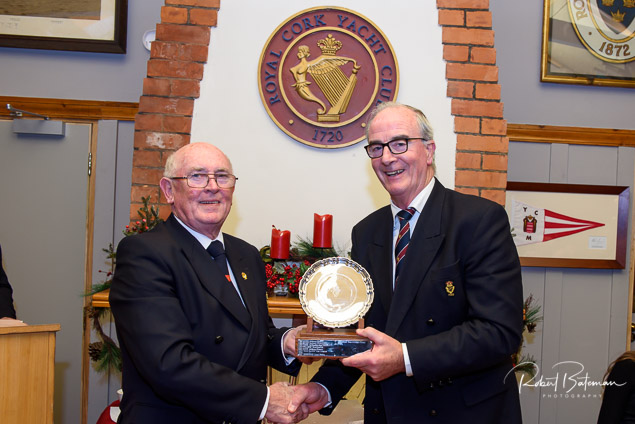 Anthony O'Leary was named RCYC Sailor of the Year
Anthony O'Leary was named RCYC Sailor of the Year
RCYC's Sailor of the Year was awarded to Anthony O'Leary who was presented with the Doyle Family Trophy for his outstanding performance in the United States in September. O'Leary and an RCYC crew took Bronze at the New York Invitational Cup as Afloat reported here
This year’s Cruising Boat of the Year Trophy was awarded to Split Point Skippered by Maeve McDonagh and Seamus Gilroy. The cruising duo embarked on a cruise of 890 nautical miles, on their Dufour 34 taking in the Isles of Scilly, Cornwall, Devon and Brittany. The cruise visited over 12 different ports, all of which had their own unique navigational and pilotage and returning to Crosshaven in Cork Harbour some 24 days later.
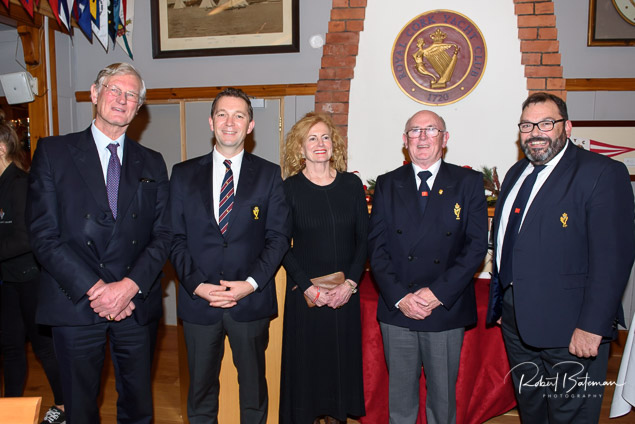 Bruce Mauleverer Royal Yacht Squadron, Gavin Deane Gen Mng. Royal Cork, Trish Lewington, Secretary Royal Yacht Squadron, Admiral Pat Farnan, Royal Cork and Colin Morehead Vice Admiral Royal Cork
Bruce Mauleverer Royal Yacht Squadron, Gavin Deane Gen Mng. Royal Cork, Trish Lewington, Secretary Royal Yacht Squadron, Admiral Pat Farnan, Royal Cork and Colin Morehead Vice Admiral Royal Cork
Michael Murphy, from RCYC and Schull Harbour Sailing Club who owns and sails the Moody 30 “Shelly D” was awarded a special prize for supporting the Autumn Leagues for 40 years in the same boat, as reported by Afloat here. Afloat Correspondent Tom MacSweeney also featured Murphy in a recent podcast here.
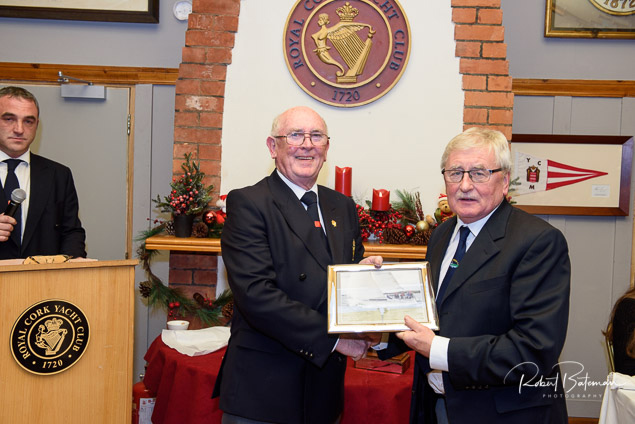 Michael Murphy, from RCYC and Schull Harbour Sailing Club “Shelly D” was awarded a special prize for supporting the Autumn Leagues for 40 years in the same boat
Michael Murphy, from RCYC and Schull Harbour Sailing Club “Shelly D” was awarded a special prize for supporting the Autumn Leagues for 40 years in the same boat
Rebecca O’Shaughnessy was awarded Under 25 Sailor of the Year, one of her achievements was being a member of Andrew Crosbie's crew onboard a National 18 that won the Royal Cork PY1000 Race back in March.
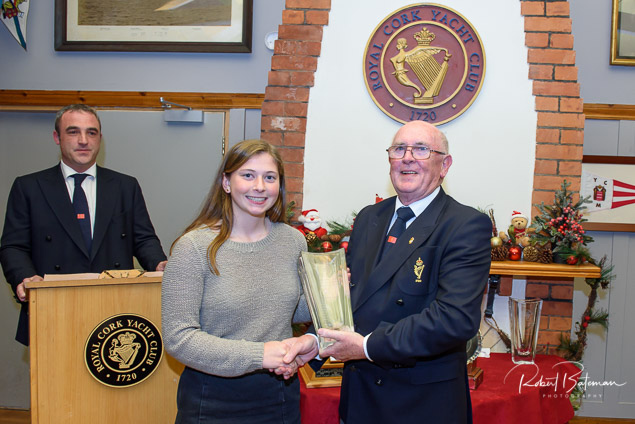 Rebecca O’Shaughnessy - Under 25 Sailor of the Year
Rebecca O’Shaughnessy - Under 25 Sailor of the Year
Celine McGrath was awarded RCYC Volunteer of the Year.
 Celine McGrath - Volunteer of the Year
Celine McGrath - Volunteer of the Year
For competing in away events, the Jones Family were awarded (National) Boat of the Year for their competitive J109 entry Jelly Baby that was unfortunately involved in a collision at the of the season in the Winter League.
 The Jones Family were awarded (National) Boat of the Year for their competitive J109 entry Jelly Baby
The Jones Family were awarded (National) Boat of the Year for their competitive J109 entry Jelly Baby
16 boats raced in last night's Royal Cork Yacht Club's Thursday night series in Cork Harbour sponsored by UK Sailmakers Ireland in a light ESE breeze writes Bob Bateman
Spinnaker fleets one and two took a beat to Corkbeg (RCYC course 93) across an ebbing tide and eased sheets to number 14 off Cuskinny a turn right to beat to East Ferry 2 back via number 12 and finish at the cage.
The five-boat whitesail fleet was given a race out the harbour to number three and then back to Cage Buoy.
Results are here
 1720 A cheery wave from the under 25 crew before the start of racing Photo: Bob Bateman
1720 A cheery wave from the under 25 crew before the start of racing Photo: Bob Bateman
 (Above and below) Ellida (Ria Lyden) took a Southerly option heading for first mark and it paid off as she won IRC1 Photo: Bob Bateman
(Above and below) Ellida (Ria Lyden) took a Southerly option heading for first mark and it paid off as she won IRC1 Photo: Bob Bateman
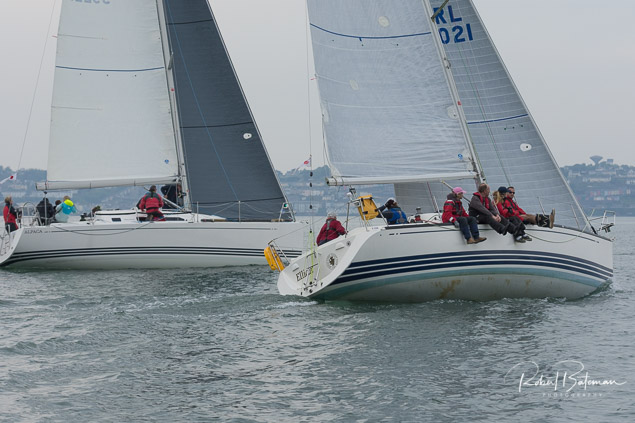
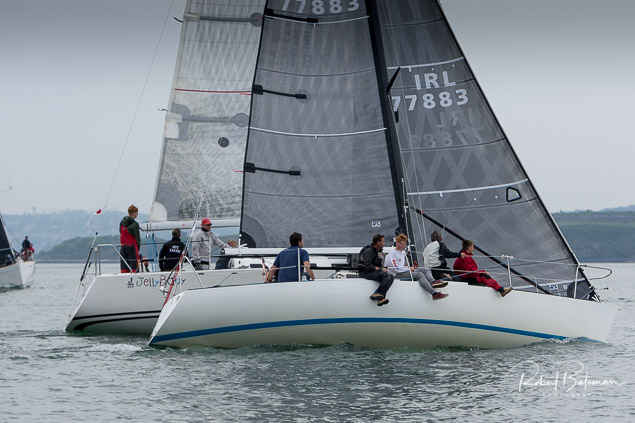 Coracle (77883) with the Collins family on board leads the event overall Photo: Bob Bateman
Coracle (77883) with the Collins family on board leads the event overall Photo: Bob Bateman
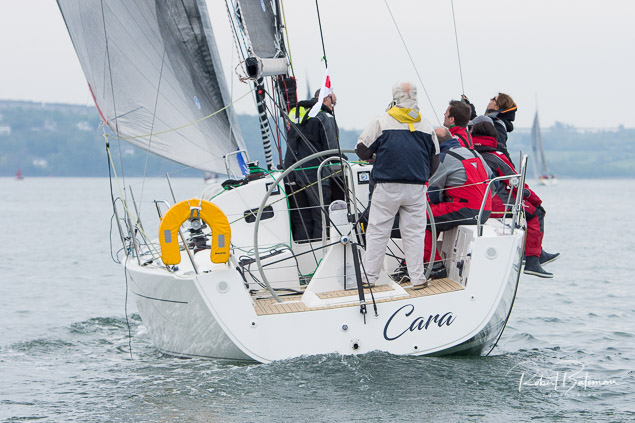 Cara Photo: Bob Bateman
Cara Photo: Bob Bateman
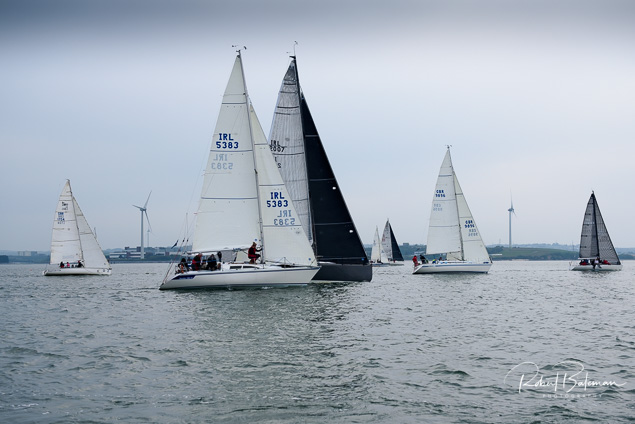
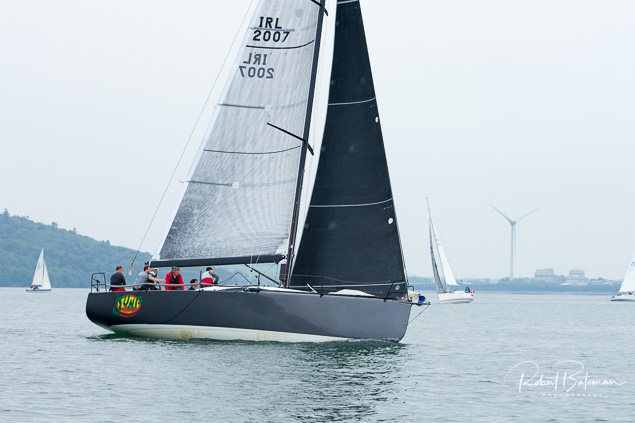 Jump Photo: Bob Bateman
Jump Photo: Bob Bateman
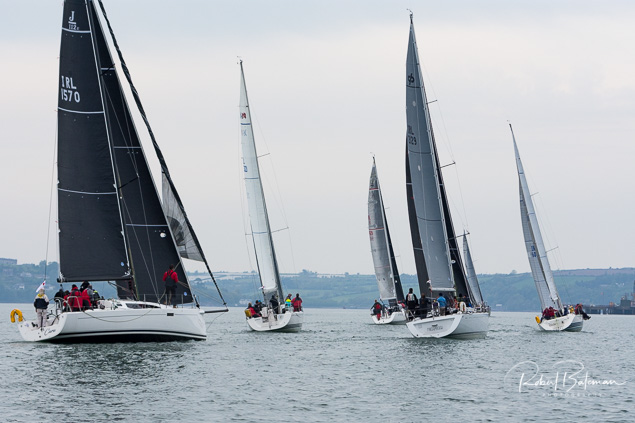 The 16-boat fleet
The 16-boat fleet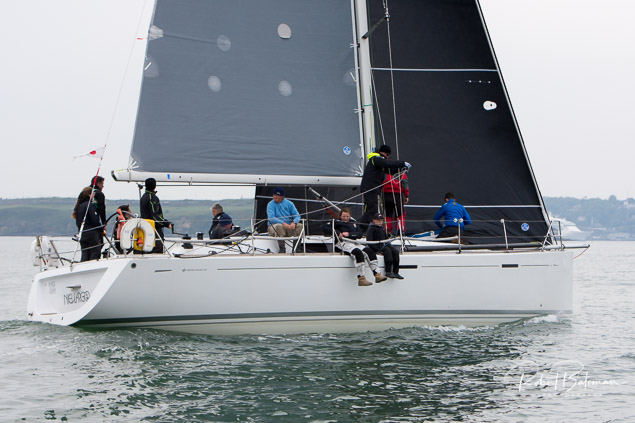 Neulargo Photo: Bob Bateman
Neulargo Photo: Bob Bateman Miss Whiplash Photo: Bob Bateman
Miss Whiplash Photo: Bob Bateman
Kinsale's O'Suilleabhain Leads Radial Irish Youths at Royal Cork Yacht Club (Photo Gallery Here!)
After a light and flukey start, Royal Cork Yacht Club sailed three races for 420s and Laser Radial classes in the first day of competition at the Irish Sailing Youth National Championships in Cork Harbour today writes Bob Bateman
In the ten–boat 420 class, the National Yacht Club's Nicola Ferguson on five points has a two-point lead from East Antrim's Lucy Kane with Morgan Lyttle of the Royal St. George Yacht Club a point behind in third.
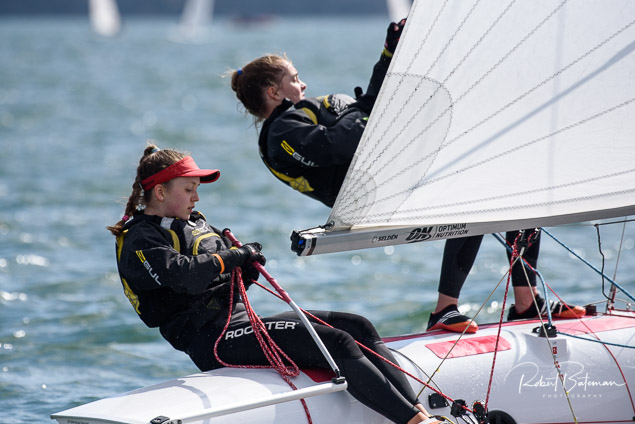 The Ferguson sisters lead the 420 class Photo: Bob Bateman
The Ferguson sisters lead the 420 class Photo: Bob Bateman
In the 28-boat Radial class, Micheal O'Suilleabhain of Kinsale on five points leads last weekend's Munster Championship winner Jamie McMahon of Howth Yacht Club by one point. Local hopes are with Atlee Kohl of RCYC on 11–points.
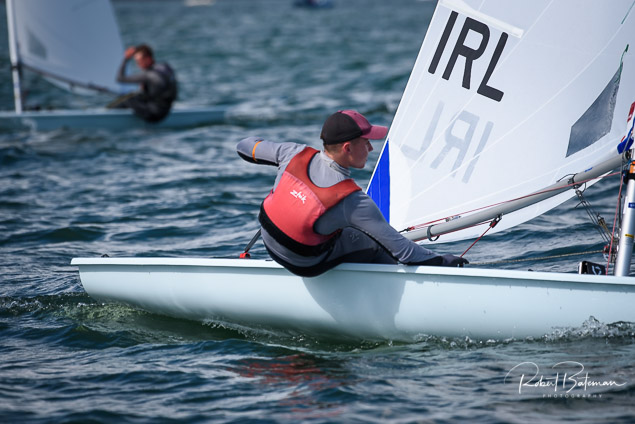 Radial leader Micheal O'Suillebhain from Kinsale Photo: Bob Bateman
Radial leader Micheal O'Suillebhain from Kinsale Photo: Bob Bateman
 Munster Championship winner Jamie McMahon lies second overall in the Radials Photo: Bob Bateman
Munster Championship winner Jamie McMahon lies second overall in the Radials Photo: Bob Bateman
In the Optimist class selection trials, James Dwyer Matthews leads this 60-boat event by just three points over Howth's Rocco Wright.
A fourth, additional race had been planned in light of forecasts of gales on Friday but after six hours on the water the fleets racing in the Cuskinny and Curlane Bank areas of Cork Harbour were sent ashore.
Racing continues tomorrow subject to forecast. Full results are here
Scroll down for photo gallery of today's action


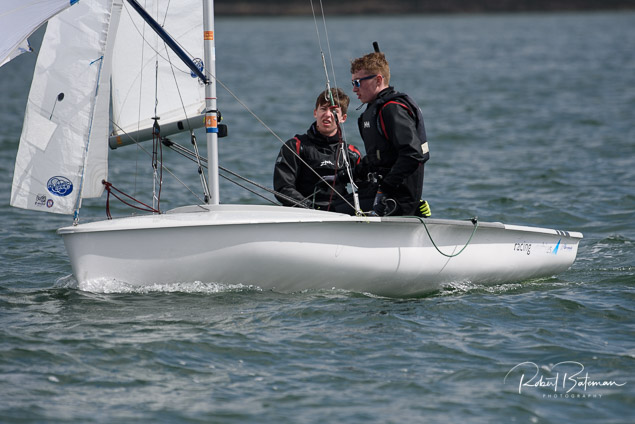
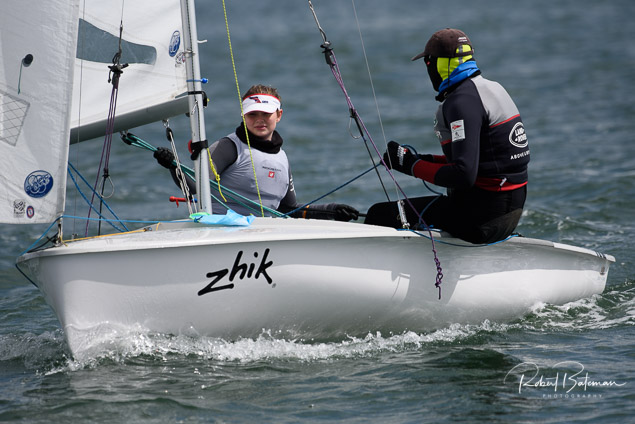
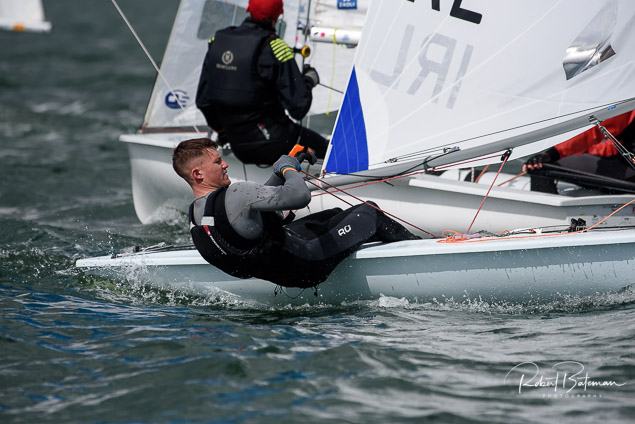
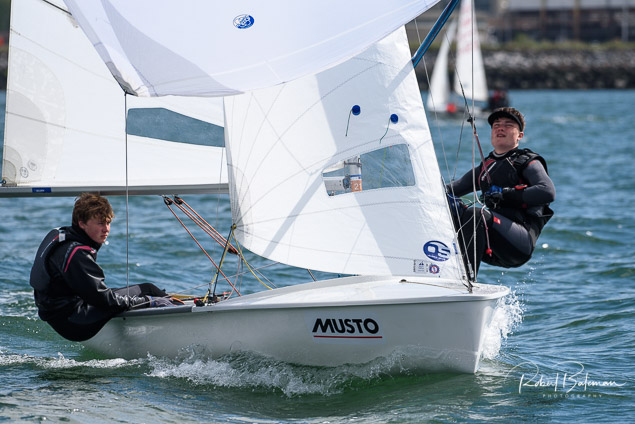
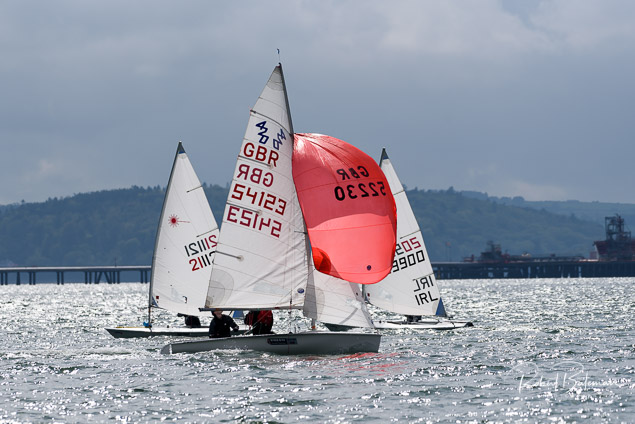

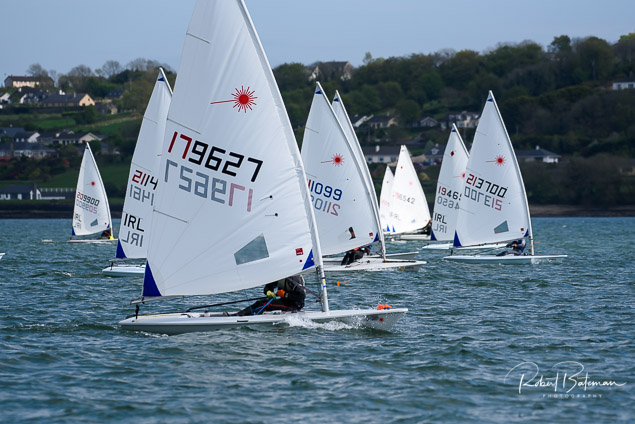
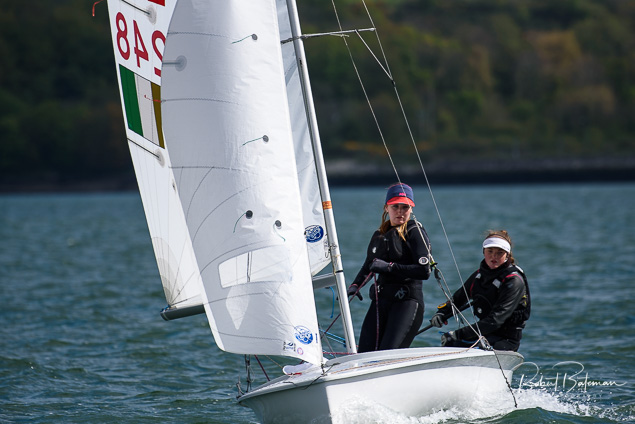
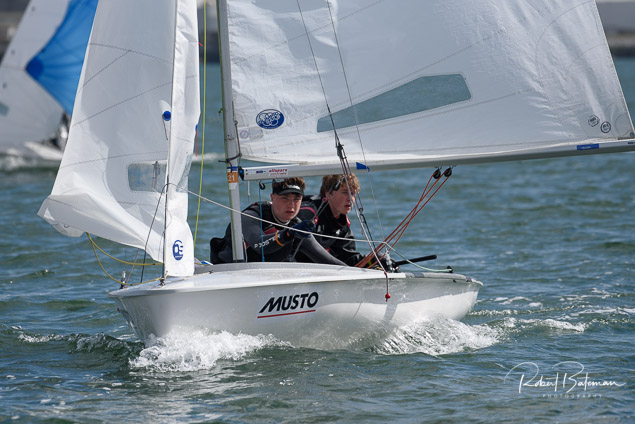

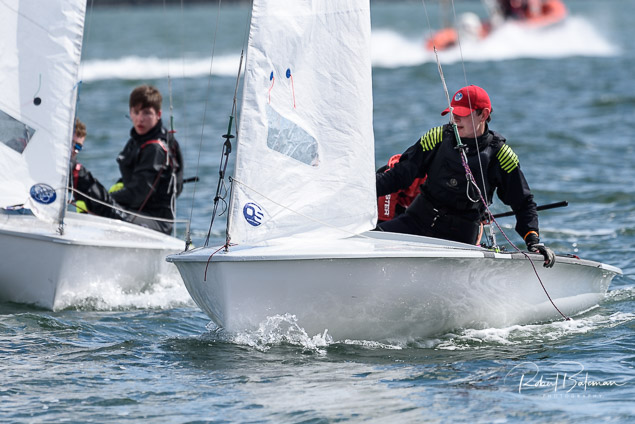
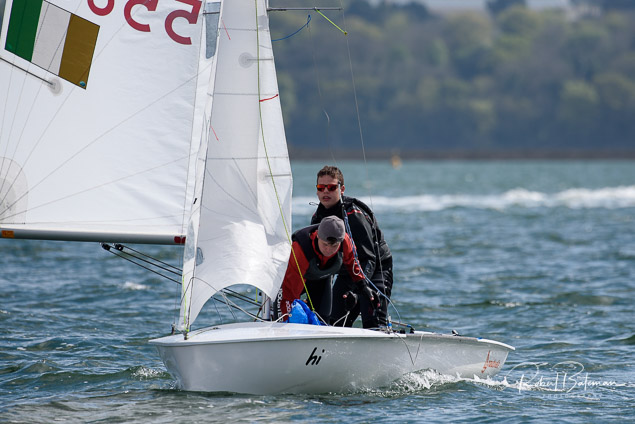



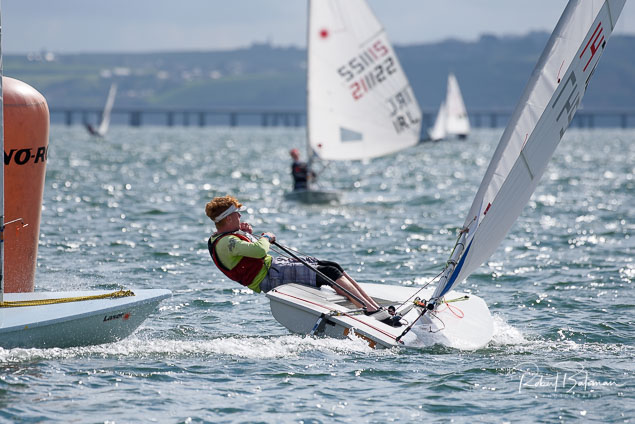
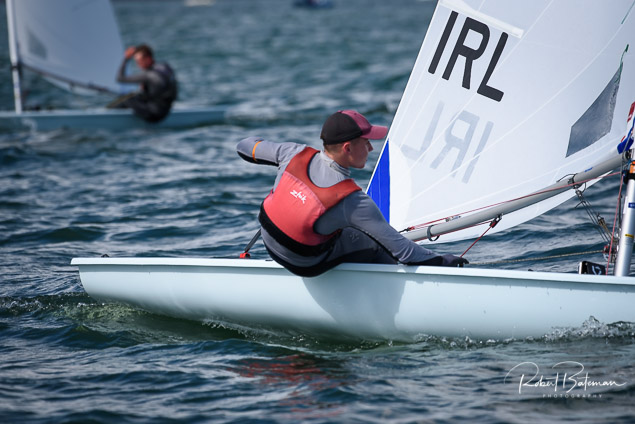


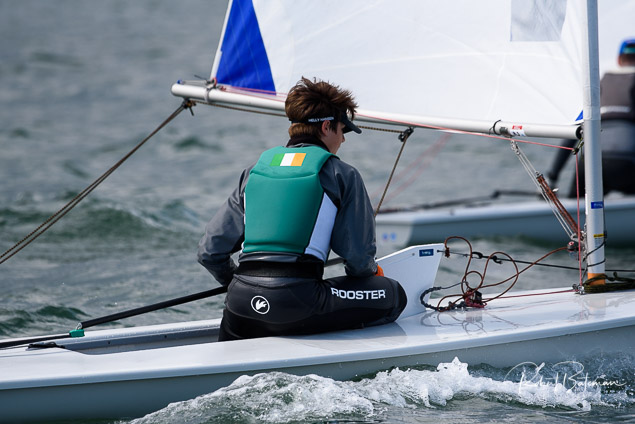
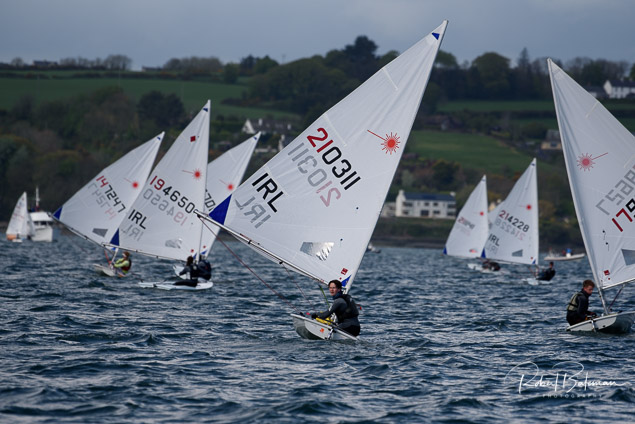
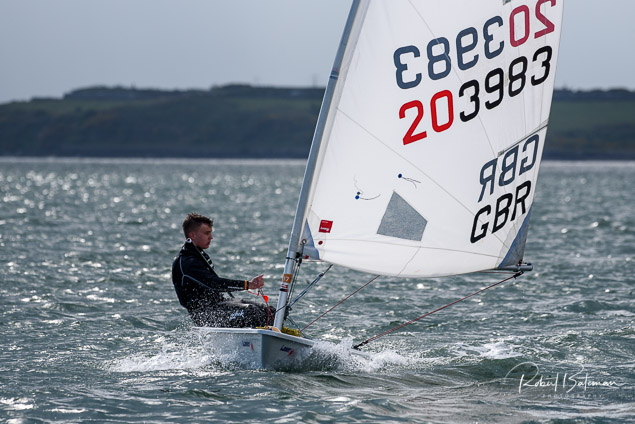
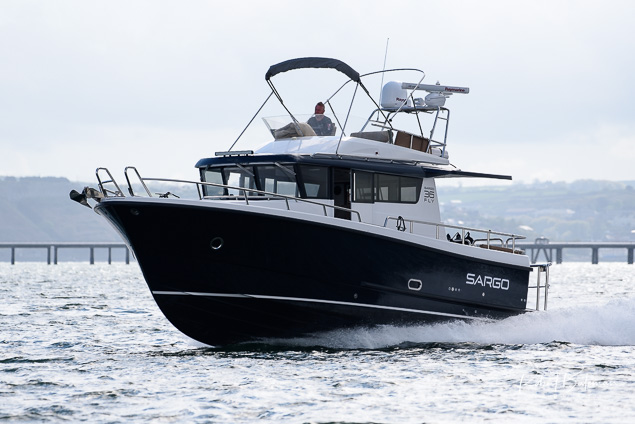
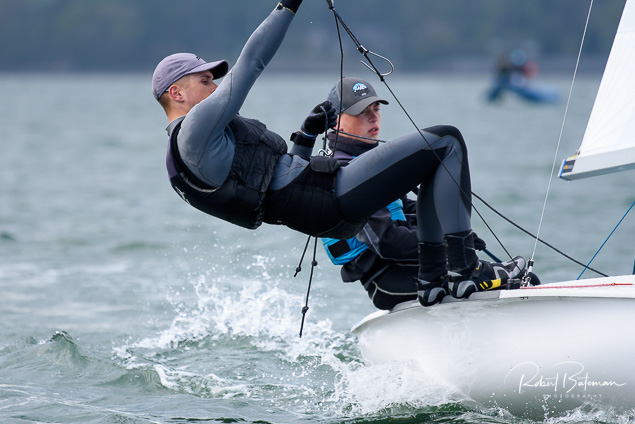
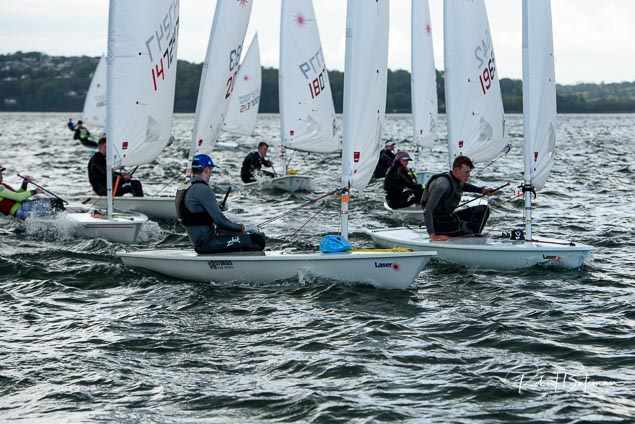
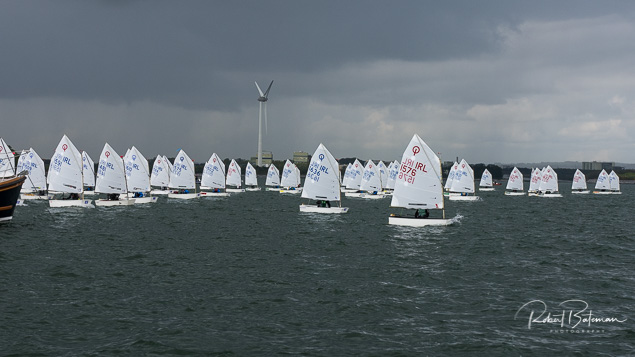

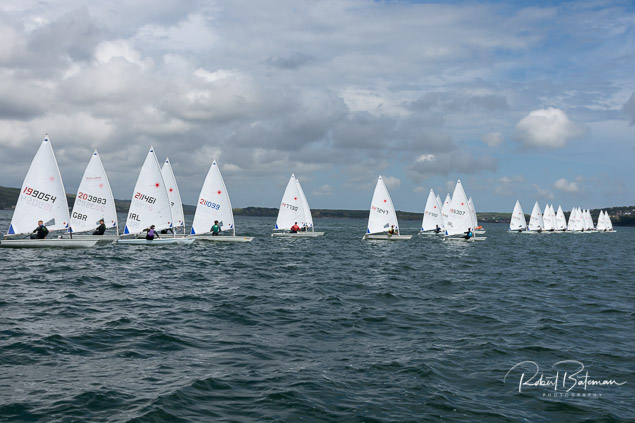
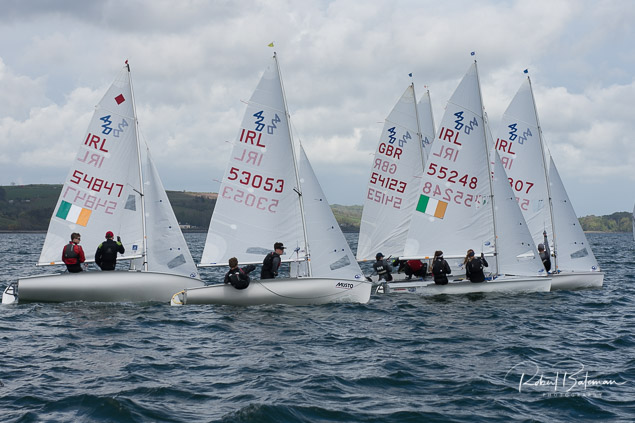
More than 150 young sailors with hopes of 'Olympic glory' will get the chance to take the first steps towards fulfilling their dreams at the Irish Sailing Youth National Championships at the Royal Cork Yacht Club later this month from 25-28 April at Crosshaven in Cork Harbour.
The competition is the one time every year when the best of Irish youth sailing come together to test their skills and ability to perform under intense competition conditions – with the added pressure of being under the spotlight for the selectors from Irish Sailing Performance.
The youngsters from throughout Ireland will compete across five different classes of boat during the weekend – the Laser Radial, Laser 4.7, 420, Topper and Optimist. These five classes have been identified, say Irish Sailing, as those that develop the necessary experience sailors need to successfully develop their skills from junior through to the Olympic classes and competing internationally.
As well as racing, there are three evening talks from members of the Irish Sailing Team. Those attending will be treated to 'inspirational talks' from Katie Tingle, who now partners Olympic silver medallist Annalise Murphy in the 49erFX as they seek Olympic qualification this year. Royal Cork's Tingle should have plenty to talk about as she will have made her international 49erFX debut in the class the week previous at the World Cup in Genoa starting on April 14.
49er sailor Séafra Guilfoyle, a silver medallist at the 2014 Youth World Championships and current partner of Ryan Seaton, who was a finalist at the Olympic Games in London 2012, and Rio 2016; and James O’Callaghan, Irish Sailing’s Performance Director, who will discuss resetting and refocusing during competition with Jessie Barr, Olympic athlete and Sport Ireland sports psychologist.
The occasion also is one of the few times where families and friends competing in the different classes can gather together in one location to share their experiences, learning and generally have some fun.
Sean Evans, Irish Sailing’s Olympic Laser Radial Academy Coach said “The Irish Sailing Youth National Championships are Ireland’s largest Youth regatta and our sport’s primary talent spotting event of the year. All the young sailors that are competing over the weekend have every chance of being selected for the Irish Sailing Academy. Sailors who demonstrate their proficiency at these championships can be chosen for squads that will be competing abroad and may even give something back by coaching and training others as well”.
Finn Lynch, just back from placing 4th in the Laser Class at the Trofeo Princesa Sofia in Palma said “I've great memories of the Youth Nationals, competing with my mates for the right to represent Ireland, racing was always great and the competition was fierce!”.
The Irish Sailing Youth National Championships, showcasing the best up-and-coming talent in Ireland, will take place from 25th-28th April at the Royal Cork Yacht Club, Crosshaven.
Rocco Wright & James Dwyer Matthews Sail Strong For Ireland At International Palamós Optimist Trophy
It was a strong seventh-place finish overall for Howth Yacht Club’s Rocco Wright at the International Palamós Optimist Trophy, which concluded yesterday (Sunday 17 February) on Spain’s Costa Brava.
The youngster remained in medal contention among a 110-boat gold fleet all the way till the final day’s racing, following a phenomenal week where he was rarely out of the top three of his groups.
James Dwyer Matthews of the Royal Cork and Kinsale Yacht Clubs also had a strong showing bettering his performance in last month’s Torrevieja Trophy, placing 12th overall.
Jessica Riordan (Royal St George YC), Anna O’Connor (Royal Irish YC), Lucia Cullen (NYC/RStG), Rachel Flood (NYC), Trevor Bolger (RStG) and Peter Williams comprised the rest of the Irish contingent on the Costa Brava during the week.





























